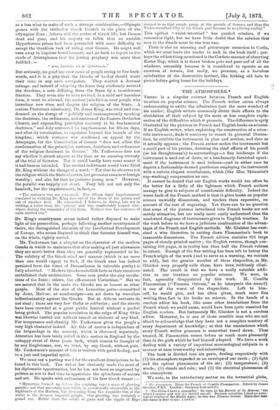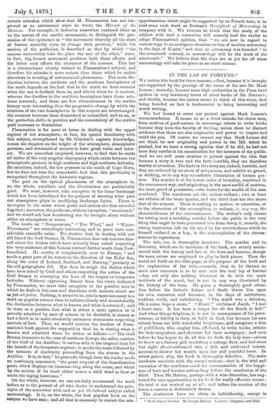THE ATMOSPHERE.*
THERE is a singular contrast between French and English treatises on popular science. The French writer seems always endeavouring to excite the admiration (not the mere wonder) of his reader; English writers commonly direct their efforts to the elucidation of their subject by the more or less complete expla- nation of the difficulties which it presents. The difference is aptly illustrated by the pictures in French and English books on science. If an English writer, when explaining the construction of a scien- tific instrument, finds it necessary to resort to pictorial illustra- tion, he exhibits the instrument in plan and section, and then as it actually appears ; the French author makes the instrument but a small part of his picture, devoting the chief efforts of his pencil (or his draughtsman's) to surroundings—a fine landscape if the instrument is used out of doors, or a handsomely-furnished apart- ment if the instrument is used indoors—and in either case he depicts a fashionably-dressed gentleman employing the instrument with a certain elegant nonchalance, which (like Miss Skimmins's cup. washing) compromises no one.
It cannot be denied that our English works would too often be the better for a little of the lightness which French authors manage to give to subjects of considerable difficulty. Indeed the worst fault of the French method is that it gives books on popular science unwieldy dimensions, and renders them expensive, on account of the cost of engraving. Yet there can be no question that some of the pictures introduced into French books are not merely attractive, but are really more easily understood than the unadorned diagrams of instruments given in English treatises. In the work before us we have a judicious combination of the advan- tages of the French and English methods. Mr. Glaisher has exer- cised a wise discretion in cutting down Flammarion's book to reasonable dimensions. The French edition contains 824 large pages of closely-printed matter ; the English version, though con- taining 500 pages, is in reality less than half the French volume in extent. Enough of the fine writing has been left to betray the French origin of the work (and to serve as a warning, we venture to add), but the greater number of these rhapsodies, as Mr. Glaisher very properly calls them, have been ruthlessly elhni- nated. The result is that we have a really valuable addi- tion to our treatises on popular science. We were, in fact, agreeably disappointed by this work. M. Camille Flammarion (" Flamma Orionis," as he interprets the namef)
is one of the worst of the rhapsodists. Left to him- self, he would give, and has often given, much more fine writing than fact in his books on science. In the hands of a careless editor his book, like some other translations from the French which we could name, would have been quite unsuited for English readers. But fortunately Mr. Glaisher is not a careless editor. Moreover, he is one of those sensible men who are not afraid to acknowledge that they have not a complete mastery of every department of knowledge ; so that the omniscience which every French writer possesses is somewhat toned down. Thus treated, M. Flammarion comes before us much more pleasantly than in the garb which he had himself adopted. We have a work dealing with a variety of important meteorological subjects in a manner at once trustworthy and intereating.
The book is divided into six parts, dealing respectively with (1) the atmosphere regarded as an envelope of our earth ; (2) light and the optical phenomena of the air ; (3) temperature; (4) winds ; (5) clouds and rain ; and (6) the electrical phenomena of the atmosphere.
We note, in the introductory matter on the terrestrial globe,
* The Atmosphere. From the French of Camille Flammarlon. Edited by James Glaisher, F.H.B. London : Sampson Low and Co.
f "For Orion I have a sympathy." he says, in his Marvels of the Heavens," for which I cannot and will not defend myself. Between ourselves, I read an astro- logical treatise of the Middle Ages; its title was Flamma 07101dS. Sines that time this name is dear tome: I love it."
certain mistakes which show that M. Flammarion has not im- proved as an astronomer since he wrote the Marvels of the Heavens. For example, it indicates somewhat confused ideas as to the nature of the earth's movements, to distinguish the pre- cession of the equinoxes as "the movement whereby all the stars of heaven annually seem to change their position," while the motion of the perihelion is described as that by which "the seasons successively take the place the one of the other," since, in fact, the, former movement produces both these effects, and the latter only affects the character of the seasons. This last is a circumstance closely related to Flammarion's subject, and therefore his mistake is more serious than those which he makes elsewhere in treating of astronomical phenomena. The main dis- tinction between the northern and the southern hemispheres of the earth depends on the fact that in the north we have summer '.when the sun is fartheFit from us, and winter when he is nearest, whereas the dwellers in the southern hemisphere have these rela- tions reversed ; and there are few circumstances in the earth's history more interesting than the progressive change by which the relations of the two hemispheres in this respect are interchanged, the contrast between them diminished or intensified, and so on, as the perihelion shifts in position and the eccentricity of the earth's path increases or diminishes.
Flammarion is far more at home in dealing with the upper regions of our atmosphere; in fact, his special familiarity with this subject, strengthened by Mr. Glaisher's cognate knowledge, causes his chapters on the height of the atmosphere, atmospheric pressure, and aeronautical ascents to have great value and inter- est. We are somewhat surprised, however, to find that he omits all notice of the very singular discrepancy which exists between the atmospheric pressure in high southern and high northern latitudes. He mentions, indeed, the low pressure to the south of Cape Horn, but he does not note the remarkable fact that this peculiarity is recognised throughout the Antarctic regions.
The part on the optical phenomena of the atmosphere is, on the whole, excellent, and the illustrations are particularly good. We must, however, take exception to the lunar landscape which has been introduced for the purpose of showing what part our atmosphere plays in modifying landscape lights. There is no region in the moon where peaks and craters are thus crowded together; moreover, the peaks are, without exception, "weathered," and we would ask how weathering can be brought about without either an atmosphere or water.
The books on "Temperature," "The Wind," and " Water- Phenomena " are exceedingly interesting, and in parts have con- siderable scientific value. We observe that in dealing with our old friend the Gulf Stream, M. Flammarion does not concern him- self about the doubts which have recently been raised respecting the very existence of this famous current farther north than New- foundland. He carries it complacently over to Europe, "and sends a great part of its waters in the direction of the Polar Sea, along the coast of Ireland, Scotland, and Norway," precisely as the old geographers did. Nor does he weigh the doubts which have been raised by Croll and others respecting the action of the Gulf Stream in conveying the heat of the tropics to-temperate latitudes. Without expressing dissent from the views indicated by Flammarion, we must take exception to the positive tone in which he deals in this case and elsewhere with matters which are as yet sub judice. Nothing, it seems to us, can be more necessary in a work on popular science than to indicate clearly and unmistakably the distinction between what is known and what is surmised ; and to state as a positive fact what is either a mere opiniou or is actually admitted by men of science to be doubtful, is almost as bad a fault as to make absolutely erroneous statements respecting matters of fact. Thus, we would caution the readers of Flam- marion's book against the supposition that he is stating what is known and admitted when he writes as follows :—" The Gulf Stream transmits to the seas of northern Europe the saline matters of the Gulf of the Antilles ; it carries with it the tropical heat for the benefit of the temperate regions ; it marks the route followed by the torrents of electricity proceeding from the storms in the Antilles. It is, in fact," he proeseds, though here the reader needs no cautionary comments, "the great serpent of the Scandinavian poets, which displays its immense ring along the ocean, and which by the motion of its head either causes a mild wind to blow or emits the raging hurricane."
On the whole, however, we can cordially recommend the work before us to the perusal of all who desire to understand the prin- ciples of the somewhat wide and as yet ill-defined subject called meteorology. It is, on the whole, the best popular book on the subject we have seen ; and all that is necessary to correct the mis-
apprehensions which might be suggested by its French tone, is to read some such work as Buchan's Handybook of Meteorology in company with it. We venture to think that the study of the subject with such a corrective will scarcely lead the reader to adopt Flammarion's opinion, that "we are now in regard to meteorology in an analogous situation to that of modern astronomy in the days of Kepler," and that as astronomy was founded "in the seventeeth century, so meteorology will be the work of the nineteenth." We believe that the days are as yet far off whea meteorology will take its place as an exact science.



































 Previous page
Previous page